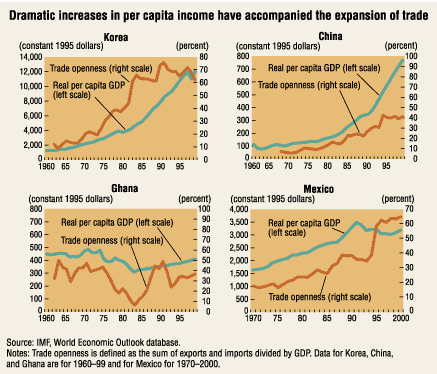

About F&D

Subscribe

Back Issues

Write Us

Copyright Information

Free Email Notification
Receive emails when we post new
items of interest to you.
Subscribe or
Modify your profile

|

|
 |

|

Picture this
Globalization: The Story Behind the Numbers
Has globalization raised living standards?
Increased international trade and capital flows have been a major source of the unprecedented economic growth and rise in living standards globally in the postwar period. Evidence shows that countries that have opened up to the rest of the world have done better than those that have not (see chart).
What is globalization?
Globalization is characterized by increases in flows of trade, capital, and information, as well as mobility of individuals, across borders. It is not a new phenomenon—globalization has progressed throughout the course of recorded history, although not in a steady or linear fashion.
|
|
In fact, there are no successful cases of fast-growing countries that followed inward-looking policies. Even so, not all open economies have prospered, nor have all citizens of countries that have globalized. Of course, other factors—including the full range of domestic economic and social policies—also shape countries' economic growth and how the benefits of that growth are shared.

Has globalization helped the poor?
Not only does international economic integration promote economic growth but also, on average, economic growth tends to increase incomes of the poor. In fact, without economic growth, there can be no sustained poverty reduction. Globalization has also facilitated the spread of technologies that have contributed to dramatic improvements in health, life expectancy, and literacy in poorer countries and communities.
- Infant mortality rates declined on average by 50 per thousand (to 59 per thousand) from 1970 to 1999 in developing countries, versus 10 per thousand (to 6 per thousand) in developed countries.
- Life expectancy in China doubled (to 70 years) over 1960-99; in India it rose by 20 years (to 64 years); and in the United States it rose from 70 to 77 years.
- Over the past three to four decades, adult illiteracy rates have declined by 30 percentage points in China, Ghana, India, Korea, and Mexico.
Has globalization reduced inequality?
Global inequality has two dimensions: inequality among and within countries.
- Globalization has helped promote convergence of per capita incomes among countries. Per capita incomes have grown faster in globalizing developing countries (those lowering their barriers to trade) than in rich countries—5 percent versus 2.2 percent in the 1990s—and there has also been convergence of per capita incomes among the advanced economies. Non-globalizing developing countries have lagged behind.
- Within industrial countries, increased openness does not appear to be a significant cause of widening inequality. While it is true that inequality has increased within some industrial countries, this increase is linked to a widening gap between wages of skilled and unskilled labor. Evidence suggests that it is technological change, not trade with lower-wage countries, that has driven the widening gap.
- Within developing countries, inequality has increased even as income has grown for both rich and poor. However, it is wrong to link this increase in inequality solely to globalization, as many factors can affect inequality. Some of them are specific to the countries concerned (such as wars and natural disasters), while others are more general (such as technological change).
| Quick facts |
| 70% | Reduction in cost of ocean freight transport between 1920 and 1990 |
| 84% | Reduction in cost of air transport between 1930 and 1990 |
|
| $60.42 | Cost of a 3-minute telephone call from New York to London in 1960 (in 2000 U.S. dollars) |
| $0.40 | Cost of same call in 2000 |
|
| $1,869,004 | Price of computer and peripheral equipment in 1960 (relative to GDP deflator; 2000=1000) |
| $1,000 | Price of equivalent computer in 2000 |
| What should governments do? |
Problem
Countries that are not involved in globalization may become increasingly marginalized and mired in poverty.
| Policy response
This calls for poverty reduction strategies and policies to promote the integration of low-income countries into world markets. Rich countries need to open their markets to exports from developing countries.
|
|
| Globalization, like technological change, can cause short-run disruptions, such as job losses and income declines, which disproportionately hit the poor.
| Governments need to provide adequate social safety nets to mitigate the effects on the vulnerable and the poor. Governments can also reduce inequalities and help all citizens to achieve their potential through policies that provide equal opportunities, including greater access to public education and health care. |
|
| Openness to global capital markets can bring greater volatility in financial markets.
| Countries that open their financial markets need to develop strong financial systems and sound economic policies. |
| Globalization timeline
The post-1950 period and late nineteenth-early twentieth centuries witnessed the strongest sustained growth of output in recorded world history.
|
Late nineteenth-early twentieth centuries
Rapid growth in world trade was triggered by sharply falling transportation costs, reduced tariffs, and major inventions, such as the internal combustion engine, steamship, telephone, and telegraph. This expansion in exports resulted in a massive flow of capital from Western Europe to the rapidly developing countries of the Americas, Australia, and elsewhere. Migration was also very large during this period.
| 1914-50
The outbreak of the two world wars, the unsuccessful attempt to revive the gold standard, and the Great Depression gave rise to protectionist sentiment and halted global integration.
| Post-1950 period
Globalization resumed as the barriers to trade and capital flows erected in the 1930s were rolled back. Technology continued to advance, especially in the area of communications and computers. This period of globalization saw a remarkable rise in living standards and dramatic improvements in health and education.
|
Based on Paul Masson, 2001, "Globalization: Facts and Figures," IMF Policy Discussion Paper 01/4 (Washington: International Monetary Fund).
|

